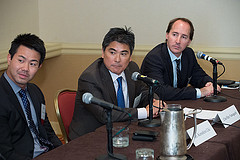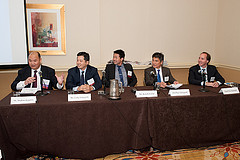Culinary Diplomacy – Connecting People of Different Nations
“Culinary Diplomacy – Connecting People of Different Nations” was one of ten panel discussions that was held on October 4, 2013, during the 4th USJC Annual Conference.
Panelists
Moderator: Mr. Stephen Kagawa, Chief Executive Officer, The Pacific Bridge Companies
Speakers: Mr. Craig Takiguchi, Former President, CEO and Co-founder, Muginoho International, Inc., parent company of Beard Papa’s Sweets Café
Mr. Kenshiro Uki, General Manager, Sun Noodle New Jersey LLC
Mr. Roy Yamaguchi, Chef & Founder, Roy’s
Mr. Eric Ziebold, Chef & Restaurateur, CityZen
Description
All over the world, people feel connected to their native cuisines, which hold deep social and cultural significance. Food can also serve as a common starting point for people to share tastes and ideas and as the stimulus for further communication. This session looked at how sharing food across borders can serve to promote cross-cultural dialogue and understanding and create platforms for lasting personal relationships. The panel of restaurateurs and food ambassadors delved into the people-to-people connections they have created throughout the culinary industry in both the United States and Japan. They shared stories about their successes and challenges building bridges between the Japanese and American people using food as the catalyst.
Summary
Special thanks to moderator Stephen Kagawa for providing this summary!
“Be Our Guest, Be Our Guest…” were the opening words of the U.S.-Japan Council’s introduction to its Culinary Diplomacy initiative and panel that featured two culinary wizards, Chef Eric Ziebold of CityZen and Chef Roy Yamaguchi of Roy’s. Joining them were an Ambassador of noodles and the current Ramen boom taking hold in the United States, Kenshiro Uki of Sun Noodle, as well as the strategic business mind behind the expansion success of Beard Papa’s, Craig Takiguchi. Together they discussed how people share the social and cultural significance of their favored native cuisines and food products, while providing a common starting point for people to interact, share tastes and subjects of mutual interest. They also stimulated further communication and connected lasting personal relationships.
The Council’s introduction of its Culinary Diplomacy efforts aligns its intentions with the White House and former First Lady and Secretary of State, Hillary Clinton, at least as it relates to the importance of food. She believes that “better and more effective diplomacy can happen around a dining room table than at a conference table.” During her term, Secretary Clinton took it sincerely to task, calling on Chef Ming Tsai to craft a luncheon for the visiting Chinese Vice President Xi Jinping, reasoning that the chef’s signature “East-West” cooking style would set a welcoming tone for the potentially tense conversations between President Obama and the man expected to be the future leader of China. Not only was current President Xi impressed by Tsai’s soy-marinated Alaskan butterfish and shiitake-leek spring rolls, he was also honored that the chef had taken the time to fly in and prepare it for him, and that a foreign government would show that level of cultural awareness and respect. From that auspicious beginning, a partnership emerged with the James Beard Foundation, the renowned non-profit culinary arts organization. Together they established an American Chef Corps of food pros who travel abroad as chef ambassadors, cook for visiting dignitaries, speak to groups, and find all ways to promote the virtues of American cooking and its food. Chef Ziebold is the one who was called upon to share his talent in Japan, beating his Japanese Iron Chef opponent, while serving as anchor on the three-man American team.
During Chef Ziebold’s recounting of his experiences in Japan, he shared that the Iron Chef Challenge, though a great event, paled in comparison to his most impressionable moment of the trip. For him, that moment emerged after the event itself, when the collective chefs enjoyed a meal together. Conversations evolved from tasting and sharing the significance of the food of their cultures, to their upbringing, their lifestyles and their experiences, further connecting with one another on a deeper and more personal level.
While the White House and Chef Ziebold work to soften the hearts and open the minds of the political leaders of engaged nations through satisfied palates and full bellies, Chef Roy and Brand USA work to encourage increased international visitation to the United States and to grow America’s share of the global travel market. In doing so, they aim to bring millions of new international visitors who spend billions of dollars in the United States, creating tens of thousands of new American jobs. Chef Roy shared that Brand USA is the nation’s public-private cooperative marketing organization focused on enhancing the image of the United States among worldwide travelers. In addition to consumer and travel trade marketing, advertising, events and promotions, they work with the Federal government to communicate U.S. entry and security processes that will help make the journey to and into the United States easier and more welcoming. In turn, as the United States welcomes millions of new international visitors, they work to make our country stronger, creating jobs essential to the economy and providing opportunities for millions of Americans. Chef Roy serves as the restaurant sector’s chief representative on the Board at Brand USA.
Sun Noodle’s Ramen Lab is where “ramen lovers come together to learn, eat, slurp and dream.” And that’s just part of what the second-generation leader of Sun Noodle, Kenshiro Uki, is doing to help educate not only the appreciating public, but also the ramen shops, their chefs, and even those milling the flour from which their noodles are formed. Mr. Uki and his artisan noodle-making family’s traditions and creativity are connecting people from different lands, noodle by noodle. And they’re doing it in grand style. This Hawaii-based company is turning out 3.5 tons of noodles daily out of their Los Angeles operations alone, as they quickly spread their influence across the country from Manhattan to Honolulu. They are joined by Chef Shigetoshi Nakamura, who is considered one of the best in Japan’s ramen industry by his peers. Together they are flexing to the differences between the communities they serve, even shaping city-by-city identifiable ramen in soup and type of noodle, much like the Shoyu-based ramen of Tokyo versus the much heavier tonkotsu pork-based soups of Southern Japan and the many varieties in between.
Now known as the baker of the “World’s Best Cream Puffs,” Beard Papa’s beginnings extend to its first cream puff shop in Osaka, Japan. Since then, they’ve been pumping out their unique French choux dough puffs to happy people everywhere around the world. Craig Takiguchi shared the importance of understanding and appreciating differences between the country of a product’s national origin and the country in which a product manufacturer seeks to expand. He contends that much of Beard Papa’s success in expansion resulted from strategic marketing analysis that centered first on the way of living of these new markets’ consumers. This ensured proper points of entry to garner the greatest penetration and market share, an exercise defined from place to place. With Beard Papa’s, that ultimately resulted in variations of flavor, size and texture, as well as modes of delivery most appreciated by the community it intended to serve.
Moderator Stephen Kagawa briefly shared his views as a consumer and businessman. He is the founder and CEO of The Pacific Bridge Companies, a company helping financial advisors from the different disciplines of the financial world in Asia and the United States connect and engage with one another in order to help address the global realities of the multinational people and companies they serve. A key component of his efforts involves people-to-people philosophies and the common language of good food. Regularly strategizing food and its integration in order to enhance the delivery of certain messages, they use it to properly commemorate significant milestones and to purposefully position and catalyze conversation by choice of ambiance, flavors and moods. Their clients, which include 30% of the wealthiest in Japan, are regularly entertained at Roy’s Hawaii Kai to introduce the Aloha of Hawaiian cuisine at its very best and to encourage casual and open conversation as Ohana, or family. Along with U.S.-Japan Council sponsor Aoyama Zaisan Networks and Ukai-tei, a Michelin-starred restaurant chain promoting the traditional cuisines of Japan, Stephen and Pacific Bridge also initiated the first USJC-related culinary diplomacy event. That reception and dinner highlighted the extraordinary talents of Ukai’s chef “Maestros” and the fantastic ambience of two of Ukai-tei’s incredible restaurants to introduce certain fortunate members of the Council’s leadership in the financial sector of the United States with several from Japan. Two events that followed at Roy’s in Pasadena also found great success, with banking, insurance, investment, legal and tax professionals from Japan and the United States already engaging both personally and professionally because of them.
So, with open arms and empty stomach, we say to you, in the words of the Council, allez cuisine! Food, glorious food!

